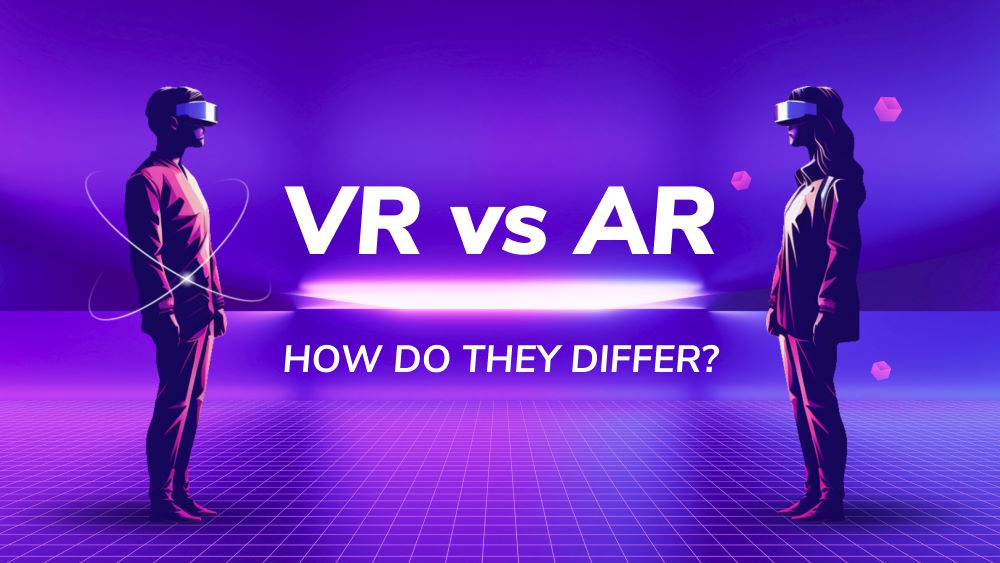VR vs. AR in Gaming: What’s the Future?
Introduction: The Rise of Immersive GamingThis is a Heading Example
In recent years, immersive gaming has become one of the most exciting and rapidly evolving trends in the tech world. Virtual Reality (VR) and Augmented Reality (AR) are at the forefront of this transformation, offering players new ways to interact with games. These technologies have already made significant strides in the gaming industry, and they are shaping how games are developed, played, and experienced.

But what is the difference between VR and AR, and how do these technologies impact the future of gaming? Let’s explore both VR and AR, how they are currently being used in gaming, and what we can expect in the future.
What is Virtual Reality (VR)?
Virtual Reality (VR) is an immersive experience that completely replaces the physical world with a digital environment. When you use a VR headset, you are transported into a completely different world, where you can interact with the environment, objects, and characters within the game. VR gaming requires specialized hardware like a VR headset, motion controllers, and sometimes additional peripherals to enhance the experience.

Key Features of VR:
- Immersive Environments: VR allows gamers to experience fully immersive environments that simulate real-world scenarios or fantastical worlds.
- Complete Disconnection from Reality: Unlike other gaming systems, VR blocks out the real world entirely, allowing players to focus solely on the digital experience.
- Enhanced Interactivity: With motion controllers, players can physically move and interact with the virtual world, enhancing the sense of immersion.
Popular VR Games:
- Beat Saber – A rhythm-based game where players use lightsabers to slice through blocks.
- Half-Life: Alyx – A highly acclaimed first-person shooter set in the Half-Life universe.
- The Walking Dead: Saints & Sinners – A survival game where players fight zombies in a post-apocalyptic world.
What is Augmented Reality (AR)?
On the other hand, Augmented Reality (AR overlays digital elements onto the real world. Instead of replacing the physical world, AR enhances it by adding layers of virtual objects, characters, and information. AR can be experienced through smartphones, tablets, or AR glasses, making it more accessible compared to VR.
Key Features of AR:
- Overlay of Digital Elements: AR takes the real world and augments it with digital images, sounds, and other sensory stimuli.
- Real-World Integration: AR games blend seamlessly with the physical world, allowing players to interact with both virtual and real-world objects.
- Ease of Access: Unlike VR, AR doesn’t require a headset, and can be enjoyed on mobile devices and smart glasses.
Popular AR Games:
- Pokémon GO – A mobile game that lets players catch Pokémon in real-world locations.
- Harry Potter: Wizards Unite – An AR game that uses the player’s surroundings to create magical experiences.
- Ingress – A geolocation-based game where players interact with the real world to complete tasks and missions.
VR vs. AR in Gaming: Key Differences
Both VR and AR are revolutionizing the gaming industry, but there are key differences between the two technologies that make them suitable for different types of gaming experiences.
| Feature | Virtual Reality (VR) | Augmented Reality (AR) |
| Immersion Level | Fully immersive; isolates the player from the real world. | Limited immersion; blends the real world with digital elements. |
| Hardware Requirements | Requires a VR headset and controllers. | Can be played on smartphones or AR glasses. |
| Interaction Style | Players interact with a completely virtual world. | Players interact with virtual elements in a real-world setting. |
| Mobility | Players are stationary or have limited mobility. | Players can move freely within their real-world environment. |
| Game Design | Focuses on creating immersive, detailed environments. | Focuses on adding interactive, digital elements to real-world spaces. |
Current Trends in VR and AR Gaming
The gaming industry is currently experiencing an exciting period of growth and experimentation in both VR and AR. As technology advances, developers are finding new ways to integrate these immersive experiences into gaming.
- The Push for More Immersive VR Experiences:
VR gaming is becoming increasingly immersive as hardware and software improve. With advancements like the Oculus Quest 2 and PlayStation VR2, gamers now have access to wireless, high-quality VR experiences. More developers are creating expansive worlds that allow players to explore, interact, and engage in entirely new ways. - Mobile AR Gaming Booms:
Mobile AR gaming has exploded in popularity, largely due to games like Pokémon GO and Harry Potter: Wizards Unite. The accessibility of AR through smartphones allows more people to experience immersive gaming without needing specialized equipment. As AR technology improves, we can expect to see more sophisticated and interactive AR games. - Integration of AI and VR/AR:
Both VR and AR are beginning to integrate AI to create more dynamic and intelligent gameplay. AI can make NPCs (non-playable characters) react more realistically to player actions, enhancing immersion. This also allows for procedurally generated environments and adaptive gameplay, creating a more personalized gaming experience. - Cross-Platform Experiences:
A new trend in VR and AR gaming is the push for cross-platform experiences. Players can engage in virtual worlds and mixed-reality environments across different devices, from mobile phones to full-fledged VR setups. This helps break down the barriers between different forms of gaming and allows for a more unified gaming ecosystem.
What’s the Future of VR and AR in Gaming?
As we look toward the future, both VR and AR hold tremendous potential in shaping the next generation of gaming. Let’s explore some exciting possibilities:
- Enhanced Social Experiences in VR:
Social VR platforms like VRChat are growing in popularity, allowing players to meet, chat, and play together in virtual spaces. In the future, VR could become a social hub where friends and strangers from all over the world can interact in digital worlds. Virtual concerts, meetups, and events will become common, blurring the line between the digital and real worlds. - AR Gaming with Smart Glasses:
The future of AR may be defined by the development of smart glasses that seamlessly integrate digital elements into the real world. Companies like Apple and Microsoft are already working on AR glasses, and it’s possible that the next wave of AR gaming will take place through these wearable devices, allowing players to experience immersive games without the need for smartphones. - Full-Body VR Gaming:
In the future, we may see the development of full-body tracking systems, allowing players to physically move and interact with VR environments in a more natural way. This could include haptic suits, motion tracking, and other technologies that allow players to truly “feel” the virtual world around them. - AR in Everyday Life:
AR could eventually go beyond gaming and become a tool for everyday life, from shopping and education to work and entertainment. AR will likely integrate seamlessly into our daily routines, enhancing the way we interact with the world around us.
Conclusion: The Future of VR and AR Gaming
The battle between VR and AR in gaming is far from over, and both technologies have their own unique advantages. While VR offers a fully immersive experience, AR brings digital elements into the real world, enhancing our interaction with the environment.
As technology continues to improve, the future of gaming will likely see the convergence of both VR and AR, creating a new form of gaming that transcends current limitations. Whether it’s fully immersive VR environments or AR games that interact with our surroundings, the possibilities are endless. For now, players can enjoy a mix of VR and AR experiences, but as the technology continues to evolve, it’s exciting to think about where the future of immersive gaming will take us.

